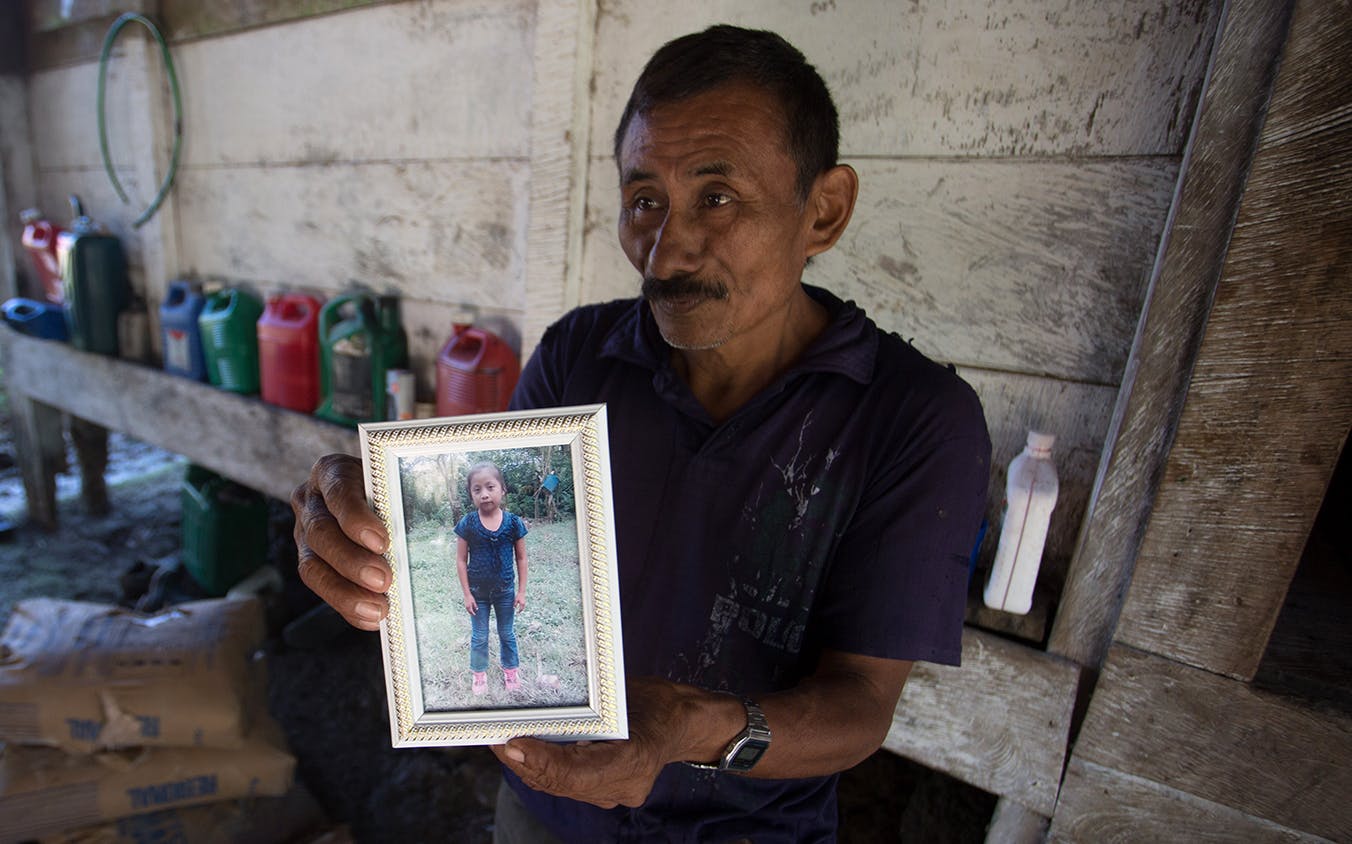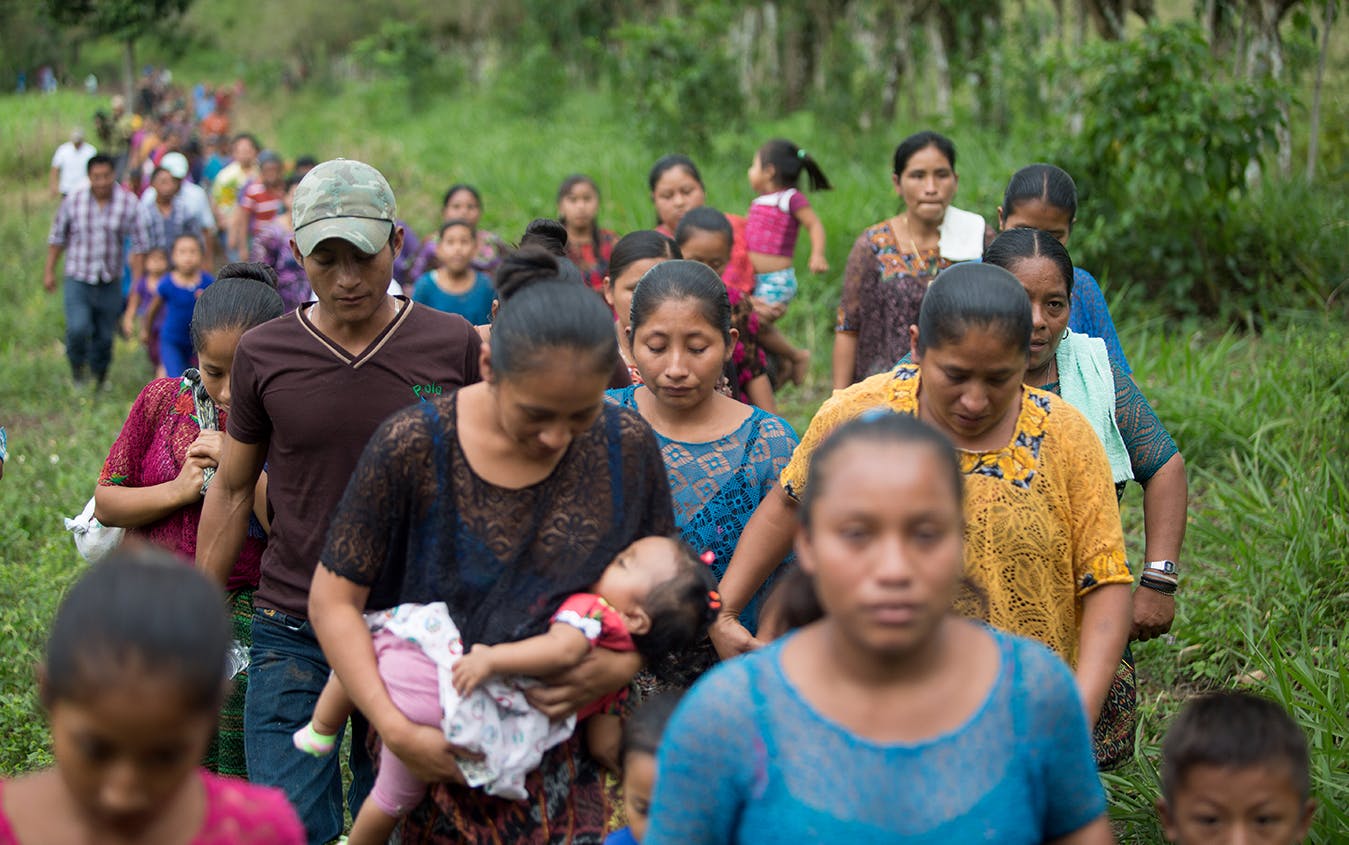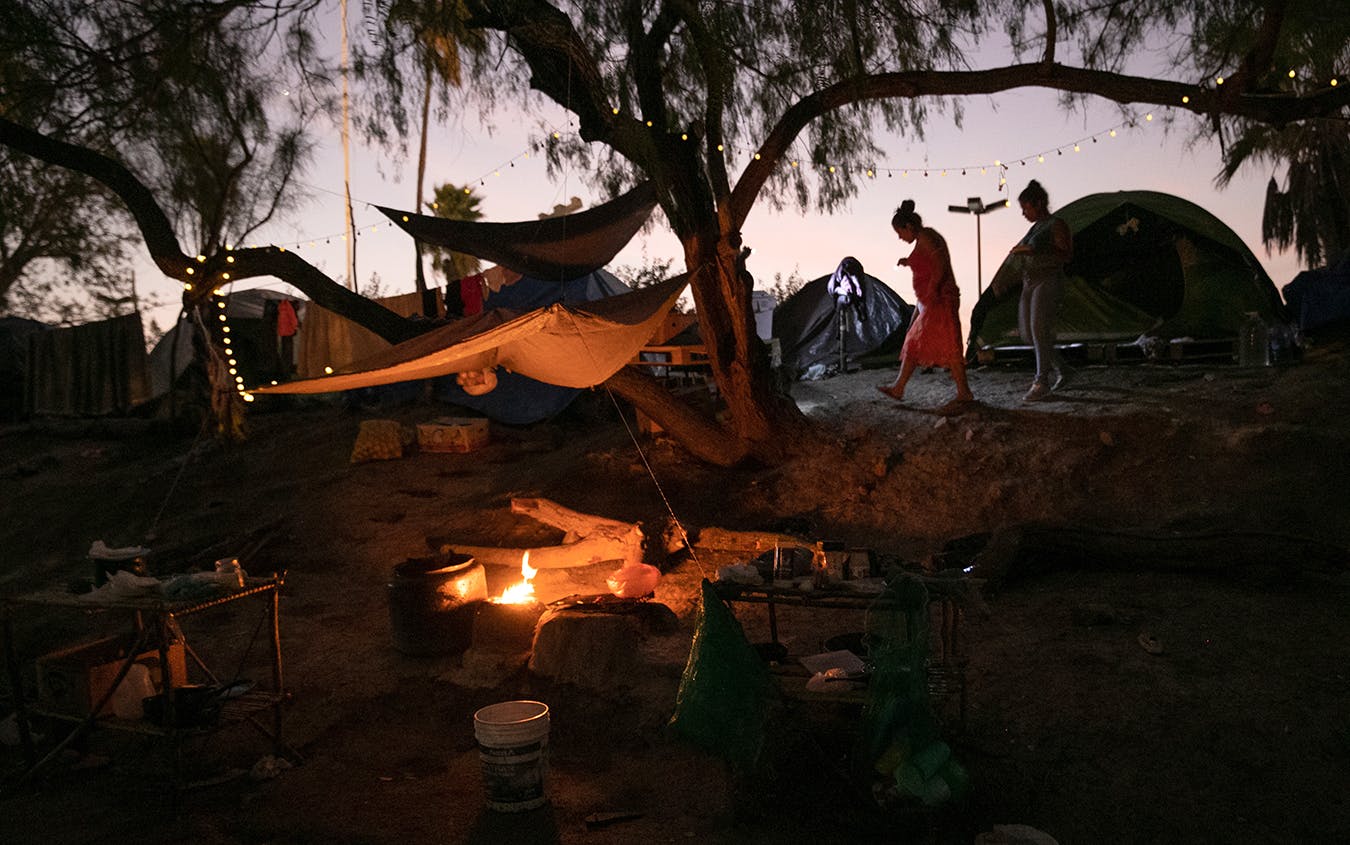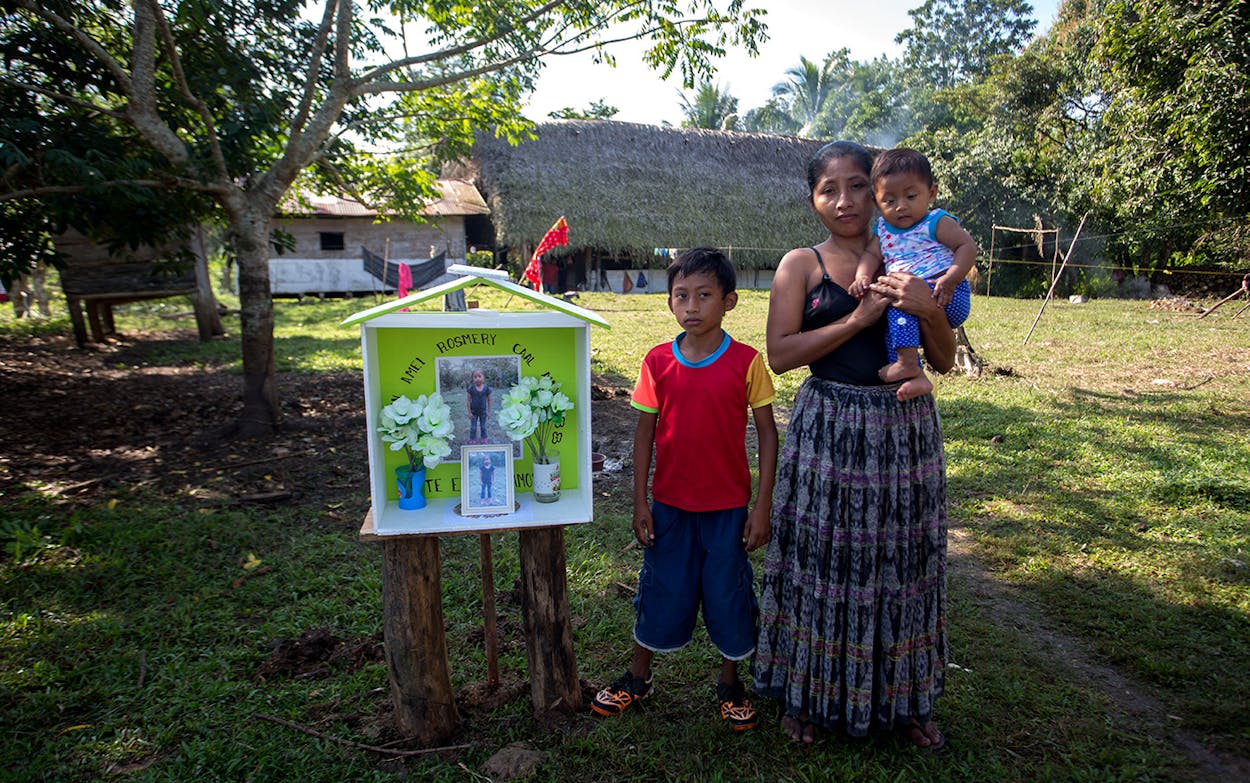The Guatemalan town of San Antonio Secortez is seven hours by car from the capital, Guatemala City, and fourteen hours by bus on winding roads that climb high into the mountains. The last part of the trip follows a one-lane road that sends passengers thrashing back and forth before finally arriving at the remote town, marked by a few rough streets and several dozen drafty homes with thatched roofs. There’s no electricity or running water in San Antonio Secortez. Most homes don’t have doors. The surrounding countryside is beautiful—lush fields of maize and beans live amid the foggy, tree-choked peaks of the Sierra Chinajá.
The fifty families who live in San Antonio Secortez—mostly Qʼeqchiʼ-speaking Mayans—grind out a living in nearby fields under the beating sun. They’re lucky if they have enough food to stave off hunger pangs all day. The majority of families are too poor to buy toys for their kids. Not many residents have ever been to Guatemala City and even fewer have gone as far as seven-year-old Jakelin Caal and her father, Nery, did back in 2018, when they traveled nearly two thousand miles to the U.S.-Mexico border.
Caal’s death in Border Patrol custody—she was the first of at least five Guatemalan minors to die in U.S. custody—in December 2018 spurred international outcry and devastated San Antonio Secortez. When I visited in September, nine months later, Jakelin’s death still hung over the community like a shroud. I’d come to see what, if anything, had changed for Jakelin’s family and young migrants like her considering the dangerous journey north.

Down a dirt path not quite wide enough for a pickup truck, past a field of maize, lives Jakelin’s mother, Claudia Maribel Maquin Coc. She’s a petite woman dressed in a pink tank top and a long, flowing skirt called a corte. Bouncing her sixteen-month-old daughter Angela on her hip, she winces at the mention of Jakelin.
“Losing a daughter is a great sorrow for a mother. Nothing can be done. Your daughter will never come back,” Maquin Coc, 27, says in Qʼeqchiʼ through a translator. Outside, Jakelin’s brothers—ages 10 and 6—squeal with joy as they chase piglets around the yard.
With Nery living in the U.S., Claudia now has to take care of their three children on her own. She cooks them tortillas and beans on the stove in the family’s single room home when she has enough food to feed them. Nery sends a few hundred dollars every few months from his wages working odd jobs in Pennsylvania. He’d like to send more, but part of his earnings go toward repaying the $10,000 he owes his smuggler.
The couple talks almost every day through WhatsApp video calls so Nery can see how fast little Angela is growing, even if it’s just through a screen. Claudia wishes she could have him near, but she knows that his living in the U.S. for at least a few years would help the family climb out of poverty. “For now, I don’t think I’ll go,” Claudia says. “But if he stays, I might go.”
While Jakelin’s death rattled the community, it hasn’t stopped migration from San Antonio Secortez, which has seen more residents leave in the past five years. Some of that’s because of agricultural conditions that have worsened partially because of climate change, but her death has also caused some people to reconsider whether the journey is worth the cost.

One of Maquin Coc’s neighbors, Concepcion Caal Cac, 59, says her 26-year-old son is contemplating joining his older brother in the U.S.—against her wishes. She worries about the many risks along the route to the American Dream: Mexican cartels that prey on migrants, dehydration in the desert or suffocation in the back of trailers, life-threatening conditions in American detention centers. Once little Jakelin returned home in a casket, the journey’s once-abstract dangers became alarmingly real to residents like Caal Cac. “Because of what happened to Jakelin, I don’t know if it’s a good idea to go anymore,” she says.
It’s been a year since Nery weighed these risks and made the decision to migrate with his daughter. Around 9 p.m. on December 6, the father and daughter crossed into the New Mexico desert and were soon greeted by the headlights of a Border Patrol truck. That delighted Jakelin, who rarely saw such bright lights at home, where the family lacked electricity. They waited until 4 a.m. to finally board a bus to the nearest Border Patrol station about two hours away. On the trip, Jakelin started to feel ill. Feverish, she began to vomit and convulse. Border Patrol agents called the station, so it could prepare to provide emergency medical care.
Jakelin wasn’t breathing when they arrived. By the time she was taken to El Paso’s Providence Children’s Hospital at 9 a.m., her condition had deteriorated. She was pronounced dead shortly after midnight on December 8. According to the autopsy, she died of streptococcal sepsis, an infection caused by bacteria associated with strep throat.
The Trump administration blamed Nery for bringing her on a dangerous journey, and the strains on the system imposed by an increase in families and children crossing the border. Activists and Democratic politicians pointed to harsh deterrence tactics and authorities’ inability to provide adequate care. Something was terribly wrong, they said, when six children had died in U.S. custody in eight months—after eight years without a minor’s death.
Amid the fallout, Kevin McAleenan, then the head of Customs and Border Protection (CBP), promised a number of reforms, including secondary medical checks for minors, quicker transfers of children out of temporary Border Patrol facilities to long-term shelters, additional medical assistance for all migrants, and more transparency about in-custody deaths. Legislators called for the Homeland Security inspector general to investigate. House Democrats introduced legislation to require CBP and ICE ensure the safety of minors in their custody. (Its progress has stalled in the House.) Nearly two thousand miles away in Guatemala, Guatemalan president Jimmy Morales promised to visit San Antonio Secortez and the mayor’s office pledged to build the family a new house, Maquin Coc says.
A year later, only some of these promises have come to fruition. In December, the inspector reform bill became stalled in Congress. The mayor’s office provided some materials for the Caal family’s new house, but construction was only half-done when I visited in September. Morales never visited, either. CBP says it’s performing secondary medical checks, but medical care for migrants in U.S. custody remains inadequate, according to Carlos Gutierrez, a pediatrician who provides volunteer medical care at the border. Medications are still confiscated once people are in custody, treatment is often delayed, and CBP refuses to give vaccinations. Activists report that minors are still routinely held in CBP facilities beyond the agency’s standard of 72 hours. Then, in May 2019, news broke of another in-custody death that hadn’t been reported to Congress at the time: a ten-year-old Salvadoran girl died eight months prior in September 2018, and legislators accused the administration of covering it up.
Though advocates are alarmed about the possibility of more deaths in custody, the greatest risk to young migrants like Jakelin Caal arguably no longer lies on the U.S. side of the border. Even as Congress held hearings on the dangers of Border Patrol facilities, Trump was laying down plans to essentially scrap the traditional asylum system that many migrants rely upon. Less than two weeks after Jakelin’s death, the administration announced the Migrant Protection Protocols, better known as the “Remain in Mexico” policy, which forces tens of thousands of migrants to wait in dangerous Mexican border cities while their cases are heard in the U.S. To date, of the 59,000 applicants, only 187 have been granted asylum. The result is that families like Jakelin’s are stranded in miserable refugee camps, where they face not just health risks but also rape, kidnapping, extortion, and murder.
Nothing can bring Jakelin back to her family, but they hope at least that no one else will endure the same suffering. One year later, were all these promises in vain?
“I don’t know if things have changed after the death of Jakelin, but for me it would be better if they change so that when [migrants] get sick, there is more attention,” says Jakelin’s grandfather Domingo Caal. “As her grandfather that’s all I ask—for those who are still migrating.”
Hundreds of thousands of Central Americans like Jakelin and Nery are still searching for a way out of their desperation. What lies ahead of them—if they choose to take the risk—is daunting.
“Those people who used to be flowing through our communities are now simply stuck in Juárez,” says El Paso Bishop Mark J. Seitz, who works with migrants on both sides of the border. “For the minds of Americans, it almost seems to be out of sight, out of mind, although they’re there at our door.”

Visitors crossing the international bridge from Brownsville to Matamoros, Mexico, are greeted by a sprawling tent city of asylum seekers, about 2,600 people as of December. Some tents are set up at the foot of the bridge, a stone’s throw from the office of Mexican immigration officials. Lines of blue, red, and orange tarps hug the river where migrants bathe and wash their clothes. The inescapable stench from nearby portable toilets, where migrants line up to wait their turn, fills the makeshift camp.
Many in the encampment are among the more than 54,000 migrants forced to stay in Matamoros under the “Remain in Mexico” program since it began in January 2019. Despite efforts by the Mexican government to relocate the refugees, most prefer to be near the bridge, where they often have to arrive before dawn to be escorted their court dates in the U.S.
When I visited the camp in October, many parents told me that their kids had gotten sick with rashes and stomach infections, likely from bathing in the nearby river and living in close quarters with so many people.
Carla is a twenty-year-old single mom from Honduras forced to stay in Mexico under “Remain in Mexico.” She said she fled Tegucigalpa because gangs would often barge into her house, where she lived along with her two-year-old son Mario, and take whatever they wanted.
Carla told me Mario had barely eaten in the month they’d been stuck in the camp. A rash recently broke out on his face, which doctors attributed to malnourishment. But Carla doesn’t have money for medicine, and is skeptical that Mexican hospitals provide quality care. “That’s why I don’t want to stay here,” she says. “So my son doesn’t get sick.”
Rodrigo, a 37-year-old from El Salvador, doesn’t want to be here in the Matamoros tent camp either. He fled El Salvador with his sons Juan and César, ages 6 and 11, when gang members demanded Rodrigo work with them. They were in Texas for a few hours—long enough to formally apply for asylum—before they were sent to Matamoros. There the boys started getting sick, suffering from vomiting, fevers, and body aches. Rodrigo scrounged up what he could for an electrolyte solution to prevent dehydration, but didn’t have enough money for medicine. “For me as a father, it’s difficult to see my kids suffer,” says Rodrigo.
Eight hundred miles away, at an overcrowded migrant shelter in Ciudad Juárez, across the border from El Paso, a volunteer nurse told me that it isn’t uncommon for kids to frequently come down with every symptom imaginable: diarrhea, vomiting, coughing, fever, body aches, sore throat, and chicken pox. The shelter only has basic remedies from donations—over-the-counter medicines and electrolyte solutions, and not much else.
“Almost all the time, the kids are sick,” says Julia, a Honduran nurse staying at the shelter while she awaits her own court date. “Recently we haven’t had donations of medicine, so now we don’t have anything in the medicine cabinet: no anti-diarrhea medicine, nothing for vomiting, nothing for pain.”
When the shelter can’t provide proper medical care, they send migrants to a local health center or hospital. In Mexico, migrants can apply for three months of health care coverage through the government, called seguro popular. But almost none of the migrants at the shelter knew this. At least one migrant told Julia a doctor refused to treat her at the hospital because she is an immigrant.
In Mexico, migrants are also vulnerable to violent crime. Beatriz, a 24-year-old Salvadoran woman, told me that she and her 10-year-old son were kidnapped by eight men with Santa Muerte tattoos—just three blocks away from the international bridge while on their way to their appointment in Laredo in September. The kidnappers let them go after they realized Beatriz didn’t have any relatives in the U.S. who could pay a ransom. They told her they never want to see her again.
“I’m scared here because of how they kidnap people,” she says at a shelter in a northern Mexican border city. “You can’t go outside because they can tell if you are a foreigner and where you are from.”
Afraid of Mexico and squeezed out of the U.S. asylum system, many migrants skirt immigration authorities in remote parts of the desert or by crossing the river, exposing themselves to more danger. Last summer, a photo went viral of Oscar Martinez and his two-year-old daughter Valeria, washed up on the riverbank near Brownsville after they drowned in the Rio Grande. In September, a Honduran mother and her 21-month-old son drowned crossing the river not far from where Oscar and Valeria were found.

Back in Matamoros, Rodrigo says he’s grown desperate waiting and waiting. “Sometimes, ideas cross your mind and you start to think maybe you can cross another way,” he says on the Gateway International Bridge one day in October when migrants staged a sit-in to protest the months-long waits in between court dates. “But the kids could drown.”
Two months later, in December, Rodrigo messaged me on WhatsApp to say he’d finally made a decision. The recent news of a Salvadoran father found dead in Tijuana with stab wounds to the neck and possible signs of torture was his breaking point. Now, he’s going to send his kids to the bridge by themselves. Rodrigo isn’t the only parent subject to Remain in Mexico who’s making that decision, either. Since November, an increasing number of parents in the Remain in Mexico program have sent their kids across the border alone, because unaccompanied minors are exempt from the program and therefore have a better shot at getting asylum. “I have to do something,” he said. “I didn’t want to, but the situation forces me to do it.”
In Philadelphia, Nery is enduring another cold winter without his family, where he has spent the majority of December and January bedridden. He can’t sleep and when he does close his eyes, he feels an unbearable weight pushing down on him. His doctor told him that it’s not the flu, a common cold, or pneumonia. He is convinced that he has a maldición, a curse. He has decided to go back to San Antonio Secortez. “I’m already packing my suitcase,” he says. “I’m leaving because I can’t take this suffering anymore. I didn’t want to go, but since I can’t take it anymore it’s what I have to do.” His wife and kids have been crying for him to return. “I’m most worried about my kids,” he says. “I have to be with my family.”
This investigation is part of Reporting the Border, a project of the International Center for Journalists in partnership with the Border Center for Journalists and Bloggers.
- More About:
- Politics & Policy
- Border Patrol






